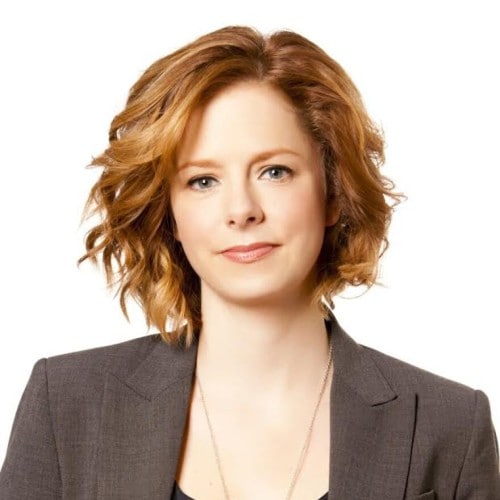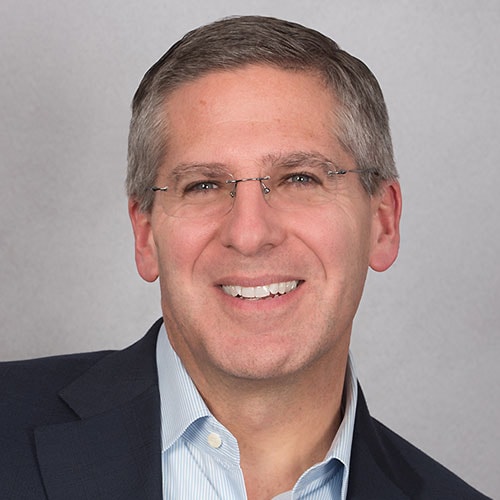

How can we reimagine workplace productivity with GenAI?
Generative AI promises to transform productivity. This Take on Tomorrow episode explores its impact on the labor market and workplace trends.
Take on Tomorrow, the award-winning podcast from our management publication strategy+business, brings you Episode 13: “How can CEOs win today’s race while running tomorrow’s?”
CEOs today face a dual imperative: how can they stay ahead of long-term threats and reinvent their companies for tomorrow’s demands while also handling the unprecedented challenges of the moment? The answer is not simple. And many CEOs are struggling to achieve an effective balance—with nearly 40% thinking their companies won’t be economically viable within a decade. In this episode, we are joined by PwC Global Chairman Bob Moritz to discuss the often-pessimistic findings of PwC’s 26th Annual Global CEO Survey, and to pinpoint positive actions that leaders can take to secure the future of their organizations.

Lizzie O’Leary
Podcaster and journalist

Bob Moritz
Former Global Chairman, PwC

2023 Webby award nominee for "Best Podcast" series


Generative AI promises to transform productivity. This Take on Tomorrow episode explores its impact on the labor market and workplace trends.


In this episode of the Take on Tomorrow podcast, business leaders from Patagonia and PwC discuss balancing environmental impact while delivering financial performance.


Discover how businesses can secure future food systems in this episode of Take on Tomorrow with Rob Cameron of Nestlé and Stuti Sethi of Strategy&.


Explore the quantum revolution's impact on business and society with experts on Take on Tomorrow.


Discover how businesses turn climate challenges into growth. Join Lizzie O’Leary at Climate Week NYC with Helen Clarkson on Take on Tomorrow by PwC.


SAP’s Chief Revenue Officer reveals what it takes to strengthen supply chain networks amid continuous disruption. Listen now.


Microsoft’s Chief Security Advisor in EMEA, Sarah Armstrong-Smith, joins the podcast to discuss how generative AI serves as both challenge and safeguard for cyber defense. Listen now.


As global urbanization accelerates, cities can position themselves to grow more inclusive and resilient by harnessing technology and data. Listen now.


How can CEOs position their businesses for success in an age of continuous reinvention? Listen now.


How can reducing energy demand accelerate the climate transition and create economic opportunity? Listen now.


The rapid advancement of generative AI is heralding a new era for workers—and charging leaders with a responsibility to navigate unprecedented opportunities. Listen now.


Discover the current impact of climate technology—and its emerging trends—in this special episode, recorded live at the COP28 climate change conference. Listen now.


Climate action is lagging, despite increased awareness of its urgency. How can progress be accelerated? Listen now.


Google’s Chief Privacy Officer, Keith Enright, joins the podcast to discuss the unique privacy challenges presented by generative AI. Listen now.


Hear exclusive insights recorded live at the premier annual summit of Asia Pacific business and government. Listen now.


‘Skills-first’ hiring allows leaders to reveal hidden potential within their teams. Hear how organizations, large or small, can adopt the approach. Listen now.


Sustainable practices aren't just good for the planet, but crucial for the long-term viability of business. Listen now.


Hear exclusive insights on the moves business can make to advance climate initiatives—recorded live at the world’s premier climate event. Listen now.


Today’s tensions vs. tomorrow’s threats: how can CEOs master the balancing act? Find out—and hear the big takeaways from our 2023 CEO Survey. Listen now.


In Episode 12 of the Take on Tomorrow podcast from strategy+business, Alison Rose, CEO of NatWest Group, explores how financial institutions are prioritising climate change.


We live in a world of ever-increasing mobility. Find out what business should do to adjust and prepare. Listen now.


The number of young people in the labor force is falling fast. Learn how businesses can give people the skills to find work and succeed. Listen now.


In Episode 9 of the Take on Tomorrow podcast from strategy+business, author Azeem Azhar exploresthe societal implications of fast-evolving technologies.


In Episode 8 of the Take on Tomorrow podcast from strategy+business, PwC’s Pete Brown explores how employers can find opportunity in an era of changing expectations.


In Episode 7 of the Take on Tomorrow podcast from strategy+business, PwC’s Ian Milborrow explores the pitfalls and potential of carbon taxation.


In Episode 6 of the Take on Tomorrow podcast from strategy+business, business ethics scholar Alison Taylor discusses how diverse stakeholders are driving change.


In Episode 5 of the Take on Tomorrow podcast from strategy+business, PwC’s Nadja Picard asks whether better reporting can lead to a more equitable future.


In Episode 4 of the Take on Tomorrow podcast from strategy+business, a Google executive and a former FDIC chair discuss the seismic changes sparked by blockchain.


In Episode 3 of the Take on Tomorrow podcast from strategy+business, a former FEMA head offers insights on managing threats, from hurricanes to supply-chain snarls.


The rapid development of covid vaccines shows that breakthrough innovation can happen at pace when needed—so what’s holding us back in other areas? Listen now.


In Episode 1 of the Take on Tomorrow podcast from strategy+business, Apple chief privacy officer Jane Horvath discusses the power—and peril—of data collection.
As reinvention pressure rises, CEOs need to rewire their decision-making.
Sharp, actionable insights curated to help global leaders build trust and deliver sustained outcomes. Explore our latest content on the global issues affecting organisations today from ESG to value creation, technology and cyber to workforce transformation.

Lizzie O’Leary: Hello and welcome to a special edition of Take on Tomorrow, the podcast from PwC’s management publication, strategy and business. I’m Lizzie O’Leary, a podcaster and journalist based in New York.
All season long, we’ve been talking to experts from around the globe to figure out what business could and should be doing to tackle some of the biggest issues we face, from climate change and workforce empowerment to technology and the future of reporting.
In this bonus episode, I’ll be digging into what thousands of CEOs from around the world are thinking about right now: how they’re looking to reinvent their companies for the future while balancing tensions today.
With me in New York is PwC’s global chairman, Bob Moritz. Welcome, Bob!
Bob Moritz: Nice to see you!
Lizzie: Bob, every year, PwC conducts a global survey of CEOs. We’re talking thousands of chief executives in more than a hundred countries around the world. The CEO Survey is now in its 26th year, and it has been a big year full of challenges, and yet CEOs also have to look to the future. Something that jumped right out at me is that four in ten of those surveyed don’t think their organizations will be economically viable in ten years’ time if they continue on their current course. What should we make of that?
Bob: It’s probably the biggest aha moment coming out of the CEO survey, and I think it reinforces, sort of, three themes. First, there’s so many different trends that are all coming together at that CEO community, all at the same time. And in the past, especially over the last decade or so, we’ve dealt with maybe two or three of them, but not as many as we have today.
Second is, the combination of all those factors may pop at any given point in time. So the unexpected is happening. We have always talked about geopolitical issues. The question is, what’s coming our way in the scenario planning that has to actually be thought about all the time now?
And, last but not least, it’s the speed of the change that’s coming. So those three things are really saying to CEOs: how do I keep up with a pace of change to remain relevant, valuable to my consumers, my business partners, and the like? And that’s why I’ve got to change so fast, and the next ten years is a long time. If I don’t keep up, I’m out of a job as well as we may be out of business.
Lizzie: So, thinking about the future, with that in mind, let’s talk about how CEOs are thinking about and evaluating future risk. There is a challenging idea contained in the survey: when does a company’s climate clock run out? About half the CEOs who responded expected to see some impact from climate change in the next 12 months, to say nothing of the longer term. What’s your view on how businesses should be managing the risks associated with climate change?
Bob: So, let’s go to the short term first. Every organization has to actually bring climate more into their overall strategy. You can’t bolt it on. And the question’s going to be for those organizations: what am I doing to change process and behavior? Do I change my supply chain? Do I incent different behaviors? And if so, how do I effect that change?
Second, you actually have to look at your supply chains right now, because everybody is going to expect a cleaner supply chain, one that is less carbon-intensive; and if you’re not changing, you’re going to get called to account. And the world has the ability to do that now through social media and otherwise. It’s not just your investors, it’s your consumers, it’s your employees, and it’s the world at large.
And third, how do I actually think about that with cost in mind?
Final point I would say is, the world’s expecting progress, and they want to compare an organization to others that they may invest in, may buy from, may be employed by. So the progress and the comparability is really important. In order to do that, provide information on what you have done, trusted information that people will make decisions on.
Lizzie: Faced with challenges like climate change, as well as cybersecurity, rising inflation, geopolitical tensions, a war in Europe—this is a very long list—more than ever, CEOs really need to consider which risks to bring forward now, and which risks they can push down their agenda. So, how do you decide?
Bob: So, all of these risks that you just described have probably been generalized and put into an enterprise-wide risk management framework, and organizations today have to do two or three things differently.
First, you’ve got to regularly review that more than once a year. Organizations used to say, “Okay, let’s take a look at this once every year or two.” The world’s moving way too fast. So you’ve got to actually look at this maybe every quarter, every month, and adjust accordingly.
Second, you’ve got to scenario plan. Geopolitical risk has always been on people’s risk assessment. The specificity and the unpredictable aspect of what happened with Russia and Ukraine? You’ve got to scenario plan for that now and be able to react very quickly.
And don’t be shy about things changing. The organizations that are going to survive are actually going to react to those risks very fast. If you can react fast, you have the opportunity to protect against downside risk and the opportunity to capture some upside potential. So, the other thing to think about is not just identifying the risks that are most important—what will you do after they actually materialize? And what will you do differently to capture it or minimize the risk associated with it?
Lizzie: So, when you’re talking about risk, though, you also have to sort of balance and deal with today. A large majority of the CEOs were pessimistic about growth, both in the global economy and then in their own companies. What are CEOs telling you about how they’re dealing with that?
Bob: So, today, the supermajority of the CEOs are pessimistic about that future, and they’re trying to be a little bit more strategic in terms of what to do. Right now, many of them coming through the survey, and what we’ve seen anecdotally, are all focused on: how do I actually cut cost as much as I can to be more effective and efficient, have the capacity to have a balance sheet that’s stronger, and be able to deal with the unpredictability that’s in front of me? And that goes to rising interest rates, debt levels, and being able to service those. But they also are taking a look at: what can I do to protect my talent as much as possible and don’t automatically jump to a restructuring or massive layoffs? The organizations that are fit for purpose will say, “How do I actually think about capturing enough upside in the opportunities that I have today?”
So, second, I would say it’s speed in the organization. What do I mean by that? Today, there’s a lot of bureaucracies in organizations. The data points you pick up if you have a supplier sitting in some part of the world and the distance between the decision to change your pricing to a product that a consumer’s going to buy—you’ve got to be really fast now.
So, what are organizations doing to take that stress, that friction cost, out of the system, so it’s speedier to make a decision on supply costs and inflation versus consumer costs?
Lizzie: Are CEOs being too pessimistic about growth, you know, are they looking at the macro environment, their own companies, and just being nervous?
Bob: So, a year ago, we were probably too optimistic on the world that we saw in front of us. Today, one could argue they’re too pessimistic, but you have to actually break up the pieces of the survey.
One is that you’ve got a view on the economy that is slowing down. That’s not pessimistic; that, I think, is appropriately supported.
The CEOs though, are actually saying, “Well, hold on a second. It won’t be as bad for me. I should be able to navigate and take advantage of opportunities here if I can execute.” And, let’s remember, CEOs, the C-suites, and management teams of these organizations have learned a lot over the last three years going through covid and the downfall that they expected but were able to manage through. So they’ve created some new tissues, some new DNA, some new muscle to figure out how to navigate through this.
So, it’s really going to be about: how do I attack the market that I see in front of us, even in a slow economy? How do I pull the levers of change and drive the change to actually go capture that opportunity in today’s economic environment?
Lizzie: So, let’s talk about this balancing act, right? How are CEOs balancing all of this—what they need for the future, what’s happening today—and how are they investing in their companies, both in terms of their own time and in terms of making concrete changes to their operations so that they can function in this environment?
Bob: So, there’s a couple of things that they’re investing in. First is the technology to actually help provide the data necessary to make quicker, faster decisions. And technology, artificial intelligence, and the like is helping in that regard.
Second, though, and it’s a very important point, is the upskilling of the talent that they have in order to be able to leverage that technology, that data, and to navigate the world and the complexities that’s in front right now. And that does require a level of upskilling, not only for the masses in these organizations but senior leadership as well. Are they fit for purpose going forward in terms of the global IQ that they should have or the digital IQ that they should have? So, super important as you think about how an organization gets aligned around what to do and where it needs to go.
And the last point is: how do I drive change, fast, in scale? And that requires a cultural element that has to be looked at, because what served you in the past over the last decade may not serve you well, never mind over the next decade but, candidly, in the next two years.
So, cultural change is going to be super important in terms of accountability with specificity and granularity on talent; expectations; data; fast, agile organizations; and that’ll allow them to survive the next two years, to thrive over the next ten.
Lizzie: Something that came up again and again from our guests on Take on Tomorrow is people, and the sort of strategy and cultural changes necessary to future-proof a company. To handle all the current and future challenges that CEOs face, they really need empowered people and an empowered organization. But the survey results show that CEOs don’t always feel like they have the conditions in place for that to happen. So, what kind of leadership do companies need from their CEOs to change things?
Bob: So, let’s take a look at the CEO community, the C-suite community, and what I’ll call the broader definition of management. You’ve got to enable trust between that management team and the broader base of employees. To be trusted, you actually have to empower, inspire, and enable. That’s super important in terms of the perception that people have of you and the trust, hopefully, that an employee has with its management team and the company itself.
Second, the world today is actually pretty complex, in that social issues are creeping into the workplace, more so than ever before. So having an environment where I can actually talk freely about those things and the implications associated with them is equally as important. And, actually, it’s a motivation for people who want to stay, if they have that opportunity.
And, last but not least, it’s: how do I actually get the people empowered to drive the change from the bottoms up? You need to give them the right skills, the opportunity, and the right data, and permission to go change process. If you do it from the bottoms up, it actually has a longer-term chance of success, as opposed to a top-down, because you might get the human-typical behavior of passive-aggressive “I didn’t invent it here, therefore it doesn’t apply to me.” So, bottoms-up empowerment, giving them permission to do that, giving them the skills, and creating trusted leadership? Really important in terms of what needs to be the investment to drive the change people are looking for.
Lizzie: Bob, if I can turn this around and flip it back to you, how do you think about the kind of investment into time and money and people that needs to be made to secure the future of PwC?
Bob: So, 18 months ago, we refreshed our strategy to focus on trust and helping organizations get to the sustained outcomes that they’re looking for. It required us to invest in our own people and upskill them. Digital skills, skills around sustainability more broadly, climate specifically, give them permission to do things differently and change the way we work. That’s a huge change.
Second, invest both time, money, and senior management’s attention, in terms of what are the businesses that are going to be needed for the future, so we can remain relevant to the clientele that we’re trying to serve. And it’s not just corporates; it’s governments, it’s community leaders and the like.
And, last but not least, it’s: we have to invest our own time to be more trusted, as well. If we’re talking about trust, it’s going to be important for us to be more trusted. So, actually, investments in our infrastructure, our quality, our quality-control systems are equally important, including for PwC to be more transparent. So, when we launched this strategy, we made some commitments in terms of investments we would make, and we’re now regularly reporting on that to make sure that our stakeholders, our clients, our people, and the like, see the progress we’re making, understand the journey we have taken on, and hopefully understand the value proposition we’re trying to bring.
Lizzie: Bob Moritz, thank you so much for joining me on Take on Tomorrow.
Bob: Great to be here.
Lizzie: PwC’s 26th Annual Global CEO Survey is out now. And if you haven’t already heard Season 1 of Take on Tomorrow, check it out. We have covered topics from climate change and global mobility to blockchain and disaster management, from the skills gap to runaway tech, and from green taxes to fostering innovation.
Take on Tomorrow is brought to you by PwC’s strategy and business. PwC refers to the PwC network and/or one or more of its member firms, each of which is a separate legal entity.
© 2023 PwC. All rights reserved. PwC refers to the PwC network and/or one or more of its member firms, each of which is a separate legal entity. Please see www.pwc.com/structure for further details.
This content is for general information purposes only, and should not be used as a substitute for consultation with professional advisors.

